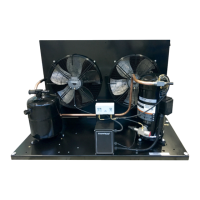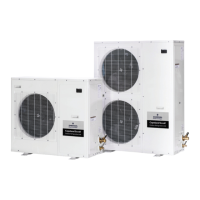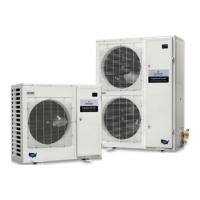Leak test (by nitrogen pressure)
Release nitrogen from system. Start vacuum pump and open main pump valve.
Evacuation
Note that the following procedure is based upon achieving an actual system vacuum stan-dard
and it is NOT TIME- DEPENDENT!
Step-by-Step:
12
Once the target vacuum level is reached, the quality of the vacuum within the system must be
tested. This is achieved by shutting off the main pump valve, allowing the internal system pressure
to rise, and recording the time taken for the vacuum to rise by no more than 300 µmHg (microns)
or 40 Pa within 30 minutes. (i.e. to 100 µmHg (microns) or 13.3 Pa). Evacuation is only complete
once the vacuum quality is achieved. Close the manifold valves tightly. Close the pump main valve,
switch off, and remove the vacuum pump.
Charging and commissioning
Step-by-step:
1. Ensure that there is no power supply to the unit. Hence, it is acceptable to leave the crankcase
heater off.
2. Connect the refrigerant cylinder to main service hose and purge line at the manifold end.
3. Invert the refrigerant cylinder if necessary to ensure only liquid refrigerant can be charged into
the system. This will be charged through the high pressure side of the manifold and liquid
service valve.
4. The refrigerant cylinder should be weighed at this point to be able to record the final
refrigerant charge. Refer to the table below for the approximate holding capacity of receiver is
at 32oC when it is 80% full. 5..Now open the liquid service valve (off the back seat). In warm
ambients, with a good vacuum in the system and the
refrigerant cylinder inverted, it may not be necessary to run the compressor.
1. Check suction capability of the vacuum pump with a gauge before commencing evacuation
process. The vacuum pump must be rated to achieve a vacuum level of at least 100 µmHg
(microns) or 13 Pa.
2. Connect the vacuum gauge to the system.
3. It is recommended to carry out the evacuation process three times as detailed below: Start
the vacuum pump and then open the main valve. It is assumed that the crank case heater is
still energized and the compressor cannot start.
Caution Ensure that the vacuum pump cannot be switched off during evacuation
–otherwise the pump may lose its lubrication oil to the system and contaminate it.
Therefore, the pump must have a Vacuum Breaker fitted to it.
4. Step 1 Evacuation: Evacuate to 1500 µmHg (microns) or 200 Pa and break vacuum to 0.1
bar with Nitrogen
5. Step 2 Evacuation: Same as in Step 1
6. Step 3 Evacuation: Leave the pump running while checking the vacuum regularly. The
target system vacuum is 500 µmHg (microns) or 67 Pa.

